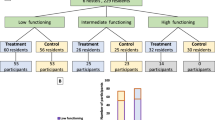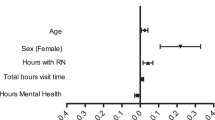Abstract
OBJECTIVE: To determine if home-centered monitoring through telemedicine has an impact on clinical characteristics, metabolic profile and quality of life in overweight and obese patients.
DESIGN: Randomized controlled trial, 6-month duration.
SETTING: Tertiary care academic hospital.
SUBJECTS: A total of 122 patients were eligible to participate as they met the inclusion criteria of increased body mass index (BMI>25 kg/m2), age>18 and <70 y and ability to operate electronic microdevices.
INTERVENTIONS: All patients in the control group (n=77) received standard hospital care. Patients in the intervention group (n=45), additionally, measured three times a week, for 6 months, their blood pressure and body weight and transmitted them to an automated call center. These values were not shared with the patients’ physician or dietician.
MAIN OUTCOME MEASURES: Clinical (body weight, BMI, blood pressure), laboratory (fasting plasma glucose, triglycerides, HDL-cholesterol, total cholesterol) and quality of life parameters (SF-36®, Visual Analog Scale of European Quality-5 Dimensions, Obesity Assessment Survey). Data were analyzed in an intention-to-treat-way (last observation carried forward).
RESULTS: Drop-out rate was similar in the control and intervention groups: 12 vs 11 percent, respectively, P=NS. There were no significant differences at baseline between intervention and control groups in all main outcome parameters. There were significant decreases for patients in the intervention group in body weight (from 101.6±22.4 to 89.2±14.7 kg, P=0.002, P=0.05 vs controls at 6 months), total cholesterol (from 247.6±42.0 to 220.7±42.6 mg/dl, P=0.002, P=0.05 vs controls at 6 months) and triglycerides (from 148.4±35.0 to 122.3±31.4 mg/dl, P=0.001, P=0.01 vs controls at 6 months). Intervention group patients made a total of 1997 phone contacts. The number of phone contacts was correlated positively with Social Functioning (SF), Vitality (VT) and Mental Health (MH) scores of SF-36® at baseline (r=0.48, r=0.41, r=0.41, respectively, P=0.05) but not with weight loss.
CONCLUSIONS: Home-centered, intense treatment through the use of telemedicine can be effective in improving short-term obesity outcomes.
This is a preview of subscription content, access via your institution
Access options
Subscribe to this journal
Receive 12 print issues and online access
$259.00 per year
only $21.58 per issue
Buy this article
- Purchase on SpringerLink
- Instant access to full article PDF
Prices may be subject to local taxes which are calculated during checkout

Similar content being viewed by others
References
Mokdad A, Serdula M, Dietz W, Bowman B, Marks J, Koplan J . The spread of the obesity epidemic in the United States, 1991–1998. JAMA 1999; 282: 1519–1522.
Mokdad A, Bowman B, Ford E, Bowman B, Marks J, Koplan J . The continuing epidemics of obesity and diabetes in the United States. JAMA 2000; 284: 1650–1651.
Allison D, Fontaine K, Manson J, Stevens J, VanItallie T . Annual deaths attributable to obesity in the United States. JAMA 1999; 282: 1530–1538.
Calle E, Thun M, Petrelli J, Rodriguez C, Heath CJ . Body-mass index and mortality in a prospective cohort of US adults. N Engl J Med 1999; 341: 1097–1105.
Must A, Spadano J, Coakley E, Field A, Colditz G, Dietz W . The disease burden associated with overweight and obesity. JAMA 1999; 282: 1523–1529.
Sjostrom C, Lissner L, Wedel H, Sjostrom L . Reduction in incidence of diabetes, hypertension and lipid disturbances after intentional weight loss induced by bariatric surgery: the SOS Intervention Study. Obes Res 1999; 7: 477–484.
National Institutes of Health. Clinical guidelines on the identification, evaluation, and treatment of overweight and obesity in adults—The Evidence Report. Obes Res 1998; 6 (Suppl 2): 51S.
Epstein L, Paluch R, Gordy C, Dorn J . Decreasing sedentary behaviors in treating pediatric obesity. Arch Pediatr Adolesc Med 2000; 154: 220–226.
Flechtner-Mors M, Ditschuneit H, Johnson T, Suchard M, Adler G . Metabolic and weight loss effects of long-term dietary intervention in obese patients: four-year results. Obes Res 2000; 8: 399–402.
Jakicic J, Winters C, Lang W, Wing R . Effects of intermittent exercise and use of home exercise equipment on adherence, weight loss, and fitness in overweight women: a randomized trial. JAMA 1999; 282: 1554–1560.
Carson E, Cramp D, Morgan A, Roudsari A . Clinical decision support, systems methodology, and telemedicine: their role in the management of chronic disease. IEEE Trans Inf Technol Biomed 1998; 2: 80–88.
Dansky K, Bowles K, Palmer L . How telehomecare affects patients. Caring 1999; 18: 10–14.
Balas E, Jaffrey F, Kuperman GJ, Boren SA, Brown GD, Pinciroli F, Mitchell JA . Electronic communication with patients. Evaluation of distance medicine technology. JAMA 1997; 278: 152–159.
Rutten GE, Maaijen J, Valkenburg AC, Blankestijn JG, de Valk HW . The Utrecht Diabetes Project: telemedicine support improves GP care in Type 2 diabetes. Diabet Med 2001; 18: 459–463.
Wojcicki JM, Ladyzynski P, Krzymien J, Jozwicka E, Blachowicz J, Janczewska E, Czajkowski K, Karnafel W . What we can really expect from telemedicine in intensive diabetes treatment: results from 3-year study on type 1 pregnant diabetic women. Diabetes Technol Ther 2001; 3: 581–589.
Biermann E, Dietrich W, Rihl J, Standl E . Are there time and cost savings by using telemanagement for patients on intensified insulin therapy? A randomized, controlled rial. Comput Methods Programs Biomed 2002; 69: 137–146.
Howells L, Wilson A, Skinner T, Newton R, Morris A, Greene S . A randomized control trial of the effect of negotiated telephone support on glycaemic control in young people with Type 1 diabetes. Diabet Med 2002; 19: 643–648.
d’Annunzio G, Bellazzi R, Larizza C, Montani S, Pennati C, Castelnovi C, Stefanelli M, Rondini G, Lorini R . Telemedicine in the management of young patients with type 1 diabetes mellitus: a follow-up study. Acta Biomed Ateneo Parmense 2003; 74: 49–55.
Gelfand K, Geffken G, Halsey-Lyda M, Muir A, Malasanos T . Intensive telehealth management of five at-risk adolescents with diabetes. J Telemed Telecare 2003; 9: 117–121.
Oh JA, Kim HS, Yoon KH, Choi ES . A telephone-delivered intervention to improve glycemic control in type 2 diabetic patients. Yonsei Med J 2003; 44: 1–8.
Mahmud K, Lenz J . The personal telemedicine system. A new tool for the delivery of health care. J Telemed Telecare 1995; 1: 173–177.
Bellazzi R, Riva A, Larizza C, Fiocchi S, Stefanelli M . A distributed system for diabetic patient management. Comput Methods Programs Biomed 1998; 56: 93–107.
Edmonds M, Bauer M, Osborn S, Lutfiyya H, Mahon J, Doig G, Grundy P, Gittens C, Molenkamp G, Fenlon D . Using the Vista 350 telephone to communicate the results of home monitoring of diabetes mellitus to a central database and to provide feedback. Int J Med Inf 1998; 51: 117–125.
di Biase N, Napoli A, Sabbatini A, Borrello E, Buongiorno A, Fallucca F . Telemedicine in the treatment of diabetic pregnancy. Ann Ist Super Sanita 1997; 33: 347–351.
Piette J, Weinberger M, McPhee S . The effect of automated calls with telephone nurse follow-up on patient-centered outcomes of diabetes care: a randomized, controlled trial. Med Care 2000; 38: 218–230.
Montani S, Bellazzi R, Quaglini S, d’Annunzio G . Meta-analysis of the effect of the use of computer-based systems on the metabolic control of patients with diabetes mellitus. Diabetes Technol Ther 2001; 3: 347–356.
Maglaveras N, Koutkias V, Chouvarda I, Goulis DG, Avramides A, Adamidis D, Louridas G, Balas E . Home care delivery through the mobile telecommunications platform: the Citizen Health System (CHS) perspective. Int J Med Info 2002; 68: 99–111.
Maglaveras N, Gogou G, Chouvarda I, Koutkias V, Lekka I, Giaglis G, Adamidis D, Karvounis C, Louridas G, Goulis D, Avramidis A, Balas EA . Communication infrastructure in a Contact Center for Home Care Monitoring of Chronic Disease Patients. Proceedings of the AMIA Annual Symposium, 2002: 479–483.
Ware J, Kosinski M, Keller S . SF-36 physical and mental health summary scales: a user's manual. The Health Institute, New England Medical Center: Boston; 1994.
Butler G, Vallis T, Perey B, Veldhuyzen van Zanten S, MacDonald A, Konok G . The Obesity Adjustment Survey: development of a scale to assess psychological adjustment to morbid obesity. Int J Obes Relat Metab Disord 1999; 23: 505–511.
Melchionda N, Marchesini G, Apolone G, Cuzzolaro M, Mannucci E, Grossi E . The QUOVADIS Study: features of obese Italian patients seeking treatment at specialist centers. Diabetes Nutr Metab 2003; 16: 115–124.
Heshka S, Greenway F, Anderson J, Atkinson R, Hill J, Phinney S, Miller-Kovach K, Xavier Pi-Sunyer F . Self-help weight loss versus a structured commercial program after 26 weeks: a randomized controlled study. Am J Med 2000; 109: 282–287.
Rossner S, Sjostrom L, Noack R, Meinders A, Noseda G . Weight loss, weight maintenance, and improved cardiovascular risk factors after 2 years treatment with orlistat for obesity. European Orlistat Obesity Study Group. Obes Res 2000; 8: 49–61.
Bray G, Blackburn G, Ferguson J, Greenway F, Jain A, Mendel C, Mendels J, Ryan D, Schwartz S, Scheinbaum M, Seaton T . Sibutramine produces dose-related weight loss. Obes Res 1999; 7: 189–198.
Garrow J, Summerbell C . Meta-analysis: effect of exercise, with or without dieting, on the body composition of overweight subjects. Eur J Clin Nutr 1995; 49: 1–10.
Pavlou K, Krey S, Steffee W . Exercise as an adjunct to weight loss and maintenance in moderately obese subjects. Am J Clin Nutr 1989; 49: 1115–1123.
Smith I, Goulder M . Randomized placebo-controlled trial of long-term treatment with sibutramine in mild to moderate obesity. J Fam Pract 2001; 50: 505–512.
Kaukua J, Pekkarinen T, Sane T, Mustajoki P . Health-related quality of life in obese outpatients losing weight with very-low-energy diet and behaviour modification: a 2-y follow-up study. Int J Obes Relat Metab Disord 2003; 27: 1072–1080.
Karlsson J, Taft C, Sjostrom L, Torgerson JS, Sullivan M . Psychosocial functioning in the obese before and after weight reduction: construct validity and responsiveness of the obesity-related problems scale. Int J Obes Relat Metab Disord 2003; 27: 617–630.
Lopez-Garcia E, Banegas Banegas JR, Gutierrez-Fisac JL, Perez-Regadera AG, Ganan LD, Rodriguez-Artalejo F . Relation between body weight and health-related quality of life among the elderly in Spain. Int J Obes Relat Metab Disord 2003; 27: 701–709.
Muls E, Kolanowski J, Scheen A, Van Gaal L . The effects of orlistat on weight and on serum lipids in obese patients with hypercholesterolemia: a randomized, double blind, placebo-controlled, multicenter study. Int J Obes Relat Metab Disord 2001; 25: 1713–1721.
Kristal A, Curry S, Shattuck A, Feng Z, Li S . A randomized trial of a tailored, self-help dietary intervention: the Puget Sound Eating Patterns study. Prev Med 2000; 31: 380–389.
Boutelle K, Kirschenbaum D, Baker R, Mitchell M . How can obese weight controllers minimize weight gain during the high risk holiday season? By self-monitoring very consistently. Health Psychol 1999; 18: 364–368.
Author information
Authors and Affiliations
Corresponding author
Rights and permissions
About this article
Cite this article
Goulis, D., Giaglis, G., Boren, S. et al. Effectiveness of home-centered care through telemedicine applications for overweight and obese patients: a randomized controlled trial. Int J Obes 28, 1391–1398 (2004). https://doi.org/10.1038/sj.ijo.0802773
Received:
Revised:
Accepted:
Published:
Issue date:
DOI: https://doi.org/10.1038/sj.ijo.0802773
Keywords
This article is cited by
-
Effectiveness of home blood pressure telemonitoring: a systematic review and meta-analysis of randomised controlled studies
Journal of Human Hypertension (2017)
-
Laparoscopic Adjustable Gastric Banding (LAGB) Aftercare Attendance and Attrition
Obesity Surgery (2015)
-
Impact of Home Blood Pressure Telemonitoring and Blood Pressure Control: A Meta-Analysis of Randomized Controlled Studies
American Journal of Hypertension (2011)
-
TECNOB: study design of a randomized controlled trial of a multidisciplinary telecare intervention for obese patients with type-2 diabetes
BMC Public Health (2010)
-
The Health-Related Quality of Life of Obese Persons Seeking or Not Seeking Surgical or Non-surgical Treatment: a Meta-analysis
Obesity Surgery (2007)



